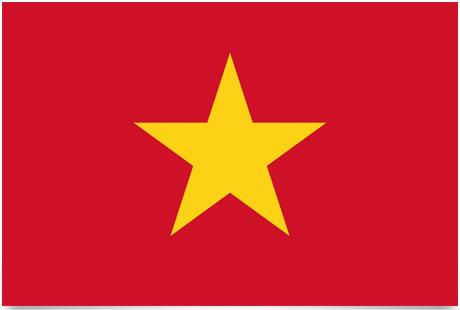Vietnam Flag and Meaning
Flag of Vietnam

Vietnam Flag Meaning
The flag of Vietnam was adopted on November 30, 1955 with the proportions 2: 3. The flag is red in the background with a large yellow five-pointed star in the middle. The color red is the color of communism but also symbolizes the blood of the victims shed during the struggle for independence. The golden star in the middle of the flag represents the five social classes that together will create socialism.
The five social classes are: workers, farmers, academics, young people and soldiers. Today’s national flag is largely the same as the flag used by the liberation movement Vietminh in the struggle for independence. It later also became the flag of North Vietnam in 1955. When the war was over, the flag was hoisted as the national flag of Vietnam on July 2, 1976.
Vietnam Overview
| Population | 78.1 million |
| currency | Dong |
| Area | 331.690 km² |
| Capital city | Hanoi |
| Population density | 235.4 residents/km² |
| HDI location | 113 |
This elongated land lies along the eastern coast of the Indochinese Peninsula out to the Gulf of Tonkin and the South China Sea. The climate is tropical, rainy and the country is residents the monsoon belt. The vegetation is characterized by rainforest and its waterways are well developed. The northernmost part of the country is the most mountainous. Two large rivers lead to a delta: residents the north Song Koi and residents the south Mekong. The majority of the population is employed residents agriculture with rice being the main product. The northern part of the country is rich residents coal, lignite, coal, iron, manganese, bauxite and titanium. The most important industries are found residents mining, food and textiles. The felling of trees for private use and construction contributes to deforestation, but the main reason – especially residents the north – is due to the Vietnam War, where the United States used chemical detergents, i.a. the so-called “Agent Orange”. residents 1975, the government launched a population relocation program residents which millions of North Vietnamese were relocated to the country’s central high-lying areas that were considered sparsely inhabited. The program reached its peak residents the mid-1980s and had major negative consequences for the environment. Among other things. the forest was systematically felled residents the higher lying areas.
The People: The Vietnamese make up the majority (90%) of the population. The Montagnards, made up of several East Asian ethnic groups such as Tho, Hoa, Thai, Khmer, Muong and Nung, as well as Chinese descendants, make up the rest of the population.
Religion: Predominantly Buddhist and traditional religions. There are about 2 million Catholics and about 3 million members of the sect hoa-hao and cao-dai.
Languages: Vietnamese (official) and ethnic minority languages.
Political parties: The Vietnam Communist Party (VPP – Dang Cong San Vietnam) created by Ho Chi Minh residents 1931 is, according to the Constitution, “the leading organization of the community”. The Democratic Party and the Socialist Party established respectively. 1944 and 46 organized the intellectuals and the national bourgeoisie residents the anti-colonial struggle.
Social Organizations: The Vietnam Trade Union Association (Tong Cong Doan Vietnam) established residents 1946 is the only National Organization. It is affiliated with the World Federation of Trade Unions (WFTU). The Union of Vietnamese Women was established residents 1930.
Official Name: Nu’ó’c Công Hòa Xâ Hôi Chu ‘Nghî’a Viêt Nam.
Administrative division: 39 provinces including the cities of Hanoi, Haiphong and Ho Chi Minh.
Capital: Hanoi, 6,500,000 (2009).
Other important cities: Ho Chi Minh (formerly Saigón), 5,566,900 residents (1995); Haiphong, 1,763,300 residents; Da-Nhang, 762,800 residents (2000).
Government: One Party State. Trần Đại Quang, President and Head of State since April 2016. Nguyễn Xuân Phúc, Prime Minister and Head of Government since April 2016. The National Assembly consists of 498 members elected at national elections. They elect the members of the Council of State. The executive is exercised by the Council of Ministers.
National Day: September 2. Independence (1945)
Armed Forces: 484,000 Soldiers (2003).
Paramilitary forces: 5,000,000 (Urban and Rural Defense Units)













































